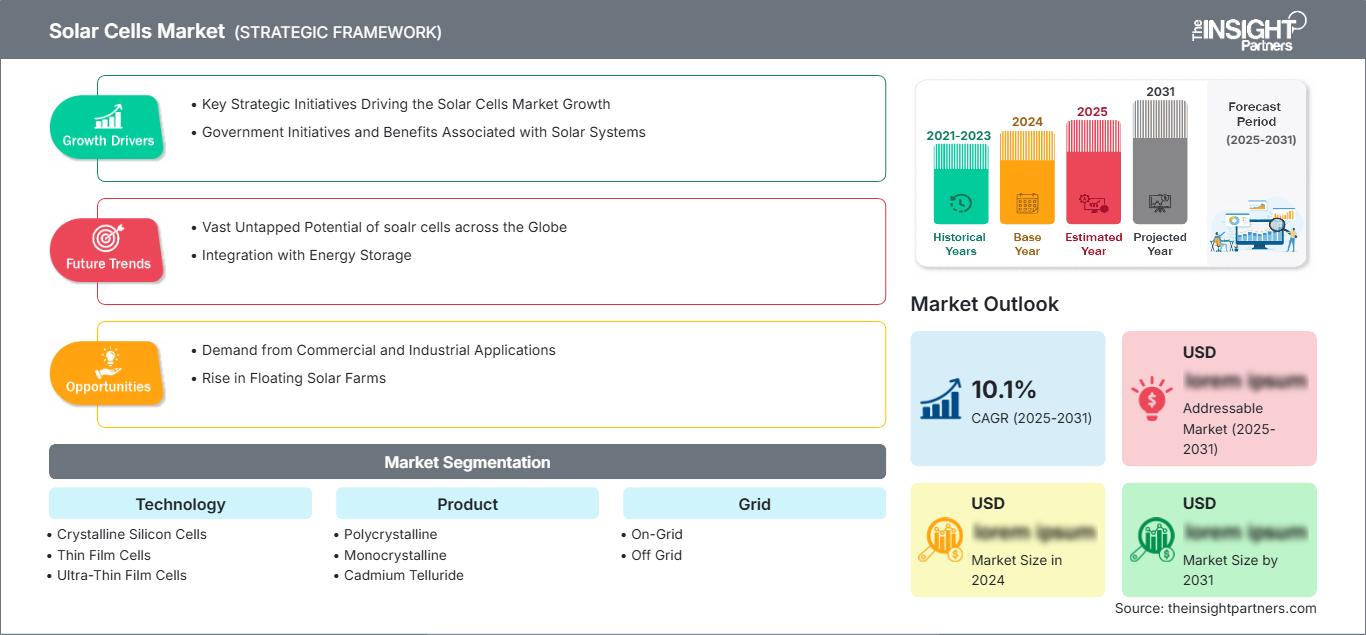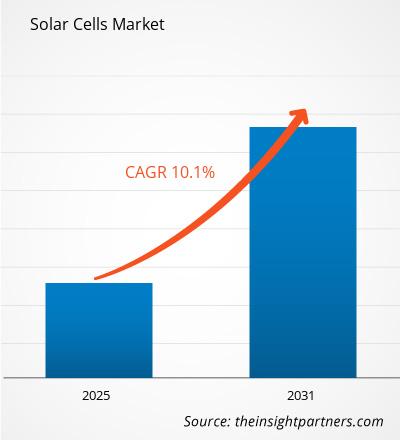页面已更新 :
Jan 2025
预计太阳能电池市场在 2025 年至 2031 年期间的复合年增长率为 10.1%,市场规模将从 2024 年的 XX 百万美元扩大到 2031 年的 XX 百万美元。
该报告按技术(晶体硅电池、薄膜电池、超薄膜电池)细分;产品(多晶硅、单晶硅、碲化镉 (CDTE)、非晶硅 (A-Si)、铜铟镓二硒化物);电网(并网、离网);应用(住宅、商业、公用事业)。全球分析进一步细分为区域和主要国家。该报告以美元提供上述分析和细分的价值。
报告目的
Insight Partners 撰写的《太阳能电池市场》报告旨在描述当前形势和未来增长、主要驱动因素、挑战和机遇。这将为各种商业利益相关者提供见解,例如:
- 技术提供商/制造商:了解不断变化的市场动态并了解潜在的增长机会,使他们能够做出明智的战略决策。
- 投资者:对市场增长率、市场财务预测和整个价值链中存在的机会进行全面的趋势分析。
- 监管机构:规范市场政策和警察活动,旨在最大限度地减少滥用,维护投资者的信任和信心,维护市场的完整性和稳定性。
太阳能电池市场细分技术
- 晶体硅电池
- 薄膜电池
- 超薄膜电池
产品
- 多晶硅
- 单晶硅
- 碲化镉
- 非晶硅
- 铜铟镓硒
电网
- 并网
- 离网
应用
- 住宅
- 商业
- 公用事业
自定义此报告以满足您的要求
您将免费获得任何报告的定制,包括本报告的部分内容,或国家级分析、Excel 数据包,以及为初创企业和大学提供超值优惠和折扣
太阳能电池市场: 战略洞察

- 获取本报告的主要市场趋势。这个免费样本将包括数据分析,从市场趋势到估计和预测。
太阳能电池市场增长动力
- 推动太阳能电池市场增长的关键战略举措:随着全球大型和新兴公司的涌现,太阳能电池市场正在显著增长。这些公司致力于投资面向消费者的太阳能电池的研发,并通过在市场上推出技术先进的太阳能产品来降低太阳能系统的成本。
- 与太阳能系统相关的政府举措和福利:重大的联邦政策变化,例如2022年8月的《通胀削减法案》(IRA),引发了一波新的太阳能投资浪潮,使太阳能市场接近实现行业目标和拜登政府雄心勃勃的清洁能源目标。太阳能技术办公室(SETO,美国能源部)致力于通过资源、研究和资金机会帮助美国居民、公司和组织发挥太阳能系统的潜力。
太阳能电池市场未来趋势
- 全球太阳能电池的巨大未开发潜力:全球各地的商业和工业场所都是分布式太阳能的主要候选地。住宅建筑、超市、仓库、农场和其他地方的太阳能电池可以帮助企业节省成本并提供大量清洁能源。太阳能系统可以将商业和工业建筑对电网的依赖降低高达 80%,并为企业节省高达 95% 的电费。例如,美国仓库的屋顶每年有潜力产生 185.6 TWh 的太阳能,足以为近 1940 万户普通家庭供电。
- 与储能的集成:太阳能电池的未来与锂离子电池等储能解决方案密切相关。太阳能发电具有间歇性,因此储能对于确保持续供电至关重要。太阳能储能系统的日益普及,尤其是在住宅和商业市场,将推动太阳能电池的需求,因为太阳能和储能系统的结合使消费者能够高效地生产、储存和使用清洁能源。
太阳能电池市场机遇
- 商业和工业应用的需求:虽然住宅太阳能装置占据了市场主导地位,但商业和工业领域也越来越多地采用太阳能发电系统。大型太阳能项目,例如工厂、购物中心和办公楼的屋顶太阳能,正在推动市场的增长。企业也受到降低能源成本和实现可持续发展目标的渴望的激励,这也增加了对太阳能电池的需求。
- 浮动太阳能发电场的兴起:安装在水库、湖泊和其他水体上的浮动太阳能系统是太阳能电池市场的一个新兴机遇。这些系统具有诸多优势,包括节省空间,以及由于水的冷却作用而提升的性能。浮动太阳能项目正日益受到青睐,尤其是在陆地空间有限但水资源丰富的国家。
太阳能电池市场
The Insight Partners 的分析师已详尽阐述了预测期内影响太阳能电池市场的区域趋势和因素。本节还讨论了北美、欧洲、亚太地区、中东和非洲以及南美和中美洲的太阳能电池市场细分和地域分布。
太阳能电池市场报告范围
| 报告属性 | 细节 |
|---|---|
| 市场规模 2024 | US$ XX million |
| 市场规模 2031 | US$ XX Million |
| 全球复合年增长率 (2025 - 2031) | 10.1% |
| 历史数据 | 2021-2023 |
| 预测期 | 2025-2031 |
| 涵盖的领域 |
By 技术
|
| 覆盖地区和国家 | 北美
|
| 市场领导者和主要公司简介 |
|
太阳能电池市场参与者密度:了解其对商业动态的影响
太阳能电池市场正在快速增长,这得益于终端用户需求的不断增长,而这些需求又源于消费者偏好的不断变化、技术进步以及对产品优势的认知度不断提升等因素。随着需求的增长,企业正在扩展产品线,不断创新以满足消费者需求,并抓住新兴趋势,从而进一步推动市场增长。

- 获取 太阳能电池市场 主要参与者概述
主要卖点
- 全面覆盖:本报告全面涵盖了对太阳能电池市场的产品、服务、类型和最终用户的分析,提供了整体格局。
- 专家分析:本报告基于对行业专家和分析师的深入了解而编写。
- 最新信息:本报告涵盖了最新信息和数据趋势,确保了业务相关性。
- 定制选项:本报告可以根据特定客户需求进行定制,并使其与业务战略相得益彰。
因此,太阳能电池市场研究报告有助于引领解读和理解行业情景和增长前景的步伐。尽管可能存在一些合理的担忧,但本报告的总体优势往往大于劣势。
- 历史分析(2 年)、基准年、预测(7 年)及复合年增长率
- PEST和SWOT分析
- 市场规模、价值/数量 - 全球、区域、国家
- 行业和竞争格局
- Excel 数据集
近期报告
相关报告
客户评价
购买理由
- 明智的决策
- 了解市场动态
- 竞争分析
- 客户洞察
- 市场预测
- 风险规避
- 战略规划
- 投资论证
- 识别新兴市场
- 优化营销策略
- 提升运营效率
- 顺应监管趋势
我们的客户































87-673-9708

ISO 9001:2015



 获取免费样品 - 太阳能电池市场
获取免费样品 - 太阳能电池市场